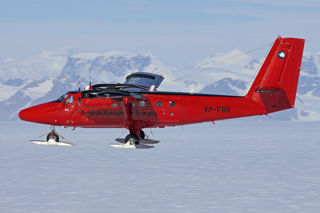
De Havilland Canada DHC-6 Twin Otter
The de Havilland Canada DHC-6 Twin Otter first flew in 1965 and is still in production to this day. The type is used as a Short Take Off and Landing utility aircraft and airliner which can land on very short airfields and unprepared airstrips. The type has been popular with Arctic and Antarctic survey missions as a support aircraft operating from ice runways, a version is also available with floats for operating from water. De Havilland ended production of the series 300 Twin Ottter in 1988 however Viking Air purchased the rights to the aircraft and began production of the modernised series 400 Twin Otter in 2010.
The British Antarctic Survey specialise in researching the Polar Regions and frozen areas of the Earth, including in the Oceans and out to the edge of the atmosphere. The Survey operate a number of research bases, and the Royal Research Ship the Sir David Attenborough together with a fleet of aircraft to assist in this endeavour. Their fleet consists of a single de Havilland Canada Dash-7 and four de Havilland Canada DHC-6-300 Twin Otters. All of their aircraft have been modified to operate in extreme frozen climates where they conduct both transport an scientific research missions.
In support of our Pushing the Boundaries in Air and Space theme, the British Antarctic Survey will be providing one of their specialised Twin Otters for static display at this year’s Air Tattoo. The aircraft will arrive at RAF Fairford from Duxford where they are based for the summer.
Photo Credit: Daniel Beedan